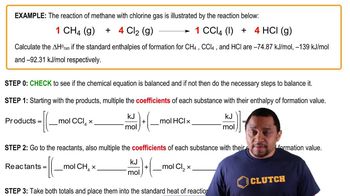Here are the essential concepts you must grasp in order to answer the question correctly.
Enthalpy of Fusion (ΔH<sub>fusion</sub>)
The enthalpy of fusion is the amount of energy required to change a substance from solid to liquid at its melting point. For ethyl alcohol, this value is given as 5.02 kJ/mol, indicating the energy needed to overcome intermolecular forces during the melting process.
Recommended video:
Enthalpy of Formation Example 1
Entropy (ΔS)
Entropy is a measure of the disorder or randomness in a system. When a solid melts into a liquid, the entropy increases because the molecules have more freedom to move. The change in entropy during fusion (ΔS<sub>fusion</sub>) can be calculated using the relationship between enthalpy and temperature.
Recommended video:
Entropy in Thermodynamics
Gibbs Free Energy and Phase Changes
The Gibbs free energy change (ΔG) during a phase change can be expressed as ΔG = ΔH - TΔS. At equilibrium, such as at the melting point, ΔG is zero, allowing us to relate ΔH<sub>fusion</sub> and ΔS<sub>fusion</sub> to find the entropy change using the formula ΔS<sub>fusion</sub> = ΔH<sub>fusion</sub> / T, where T is the absolute temperature in Kelvin.
Recommended video:
Gibbs Free Energy of Reactions
 Verified step by step guidance
Verified step by step guidance


